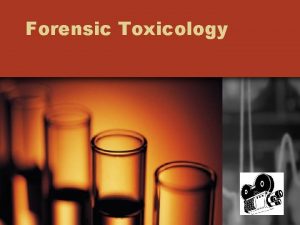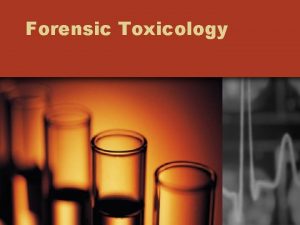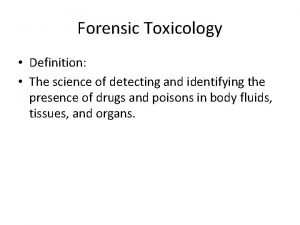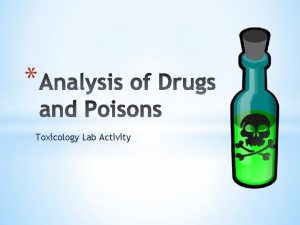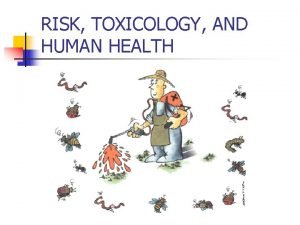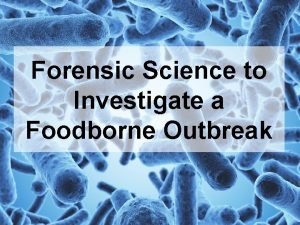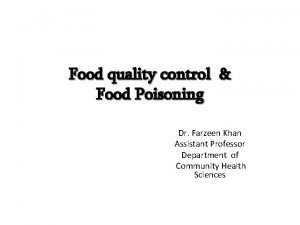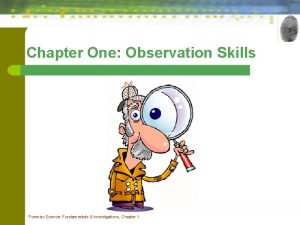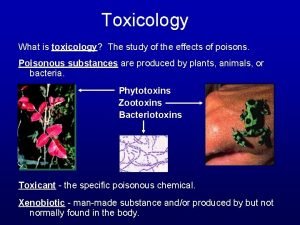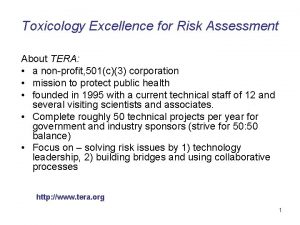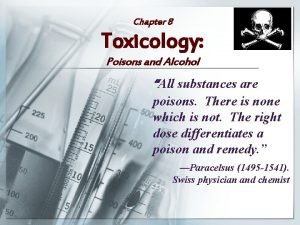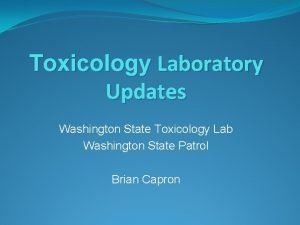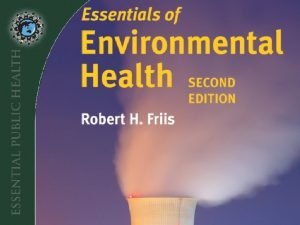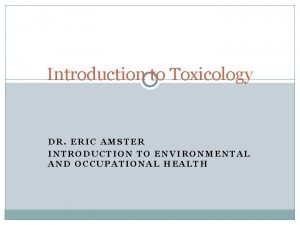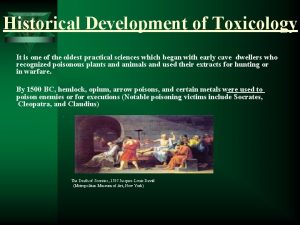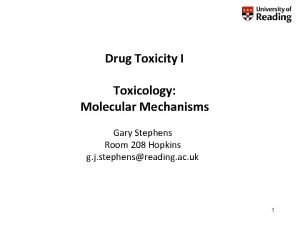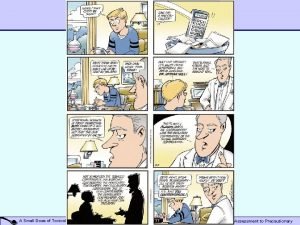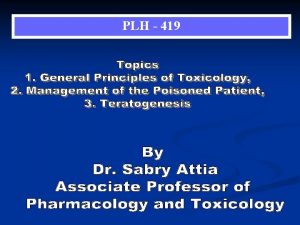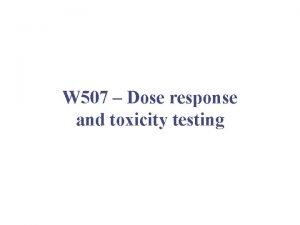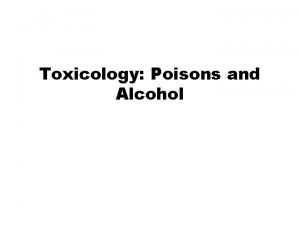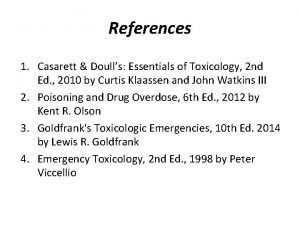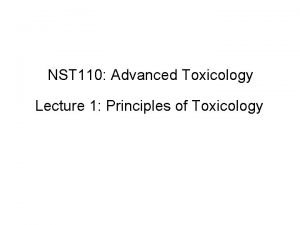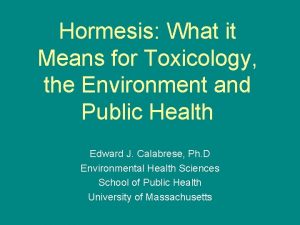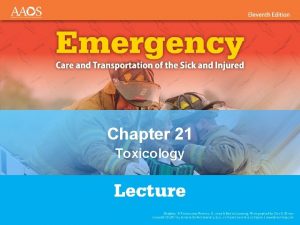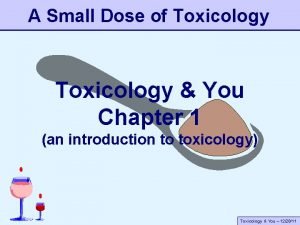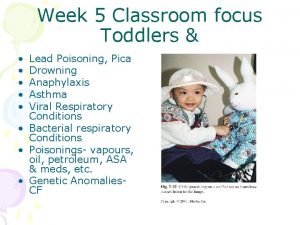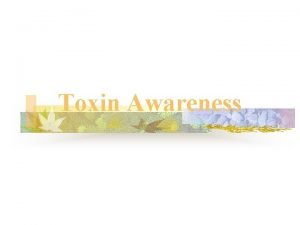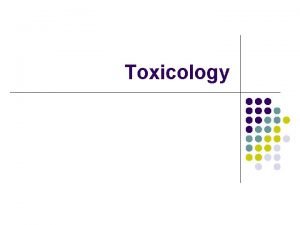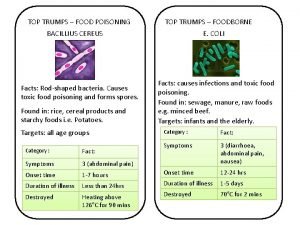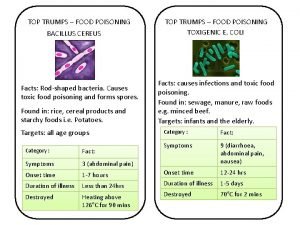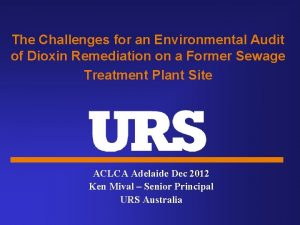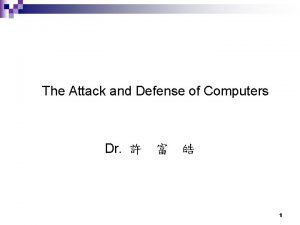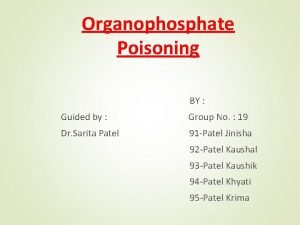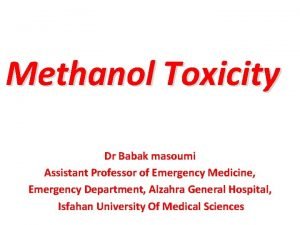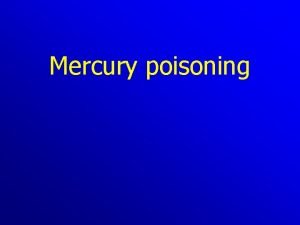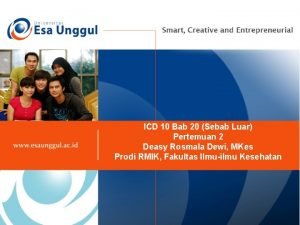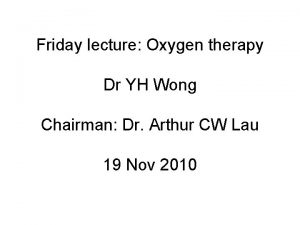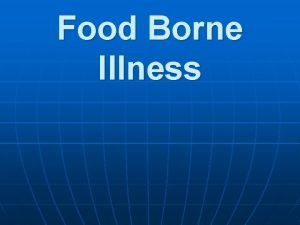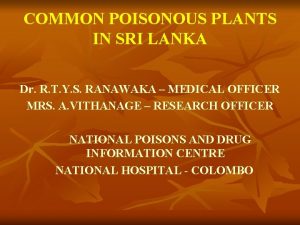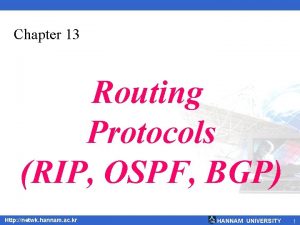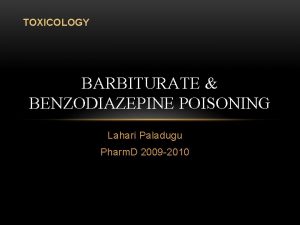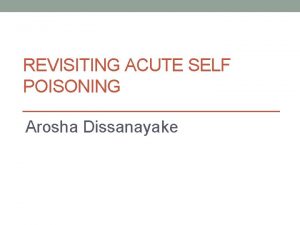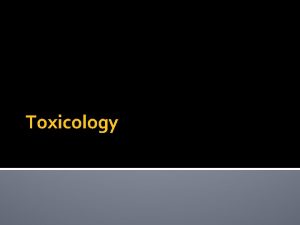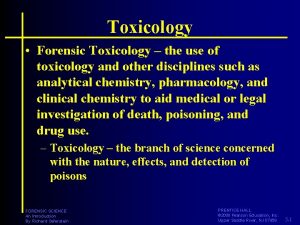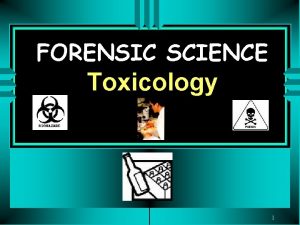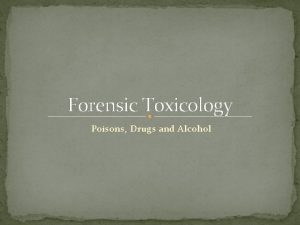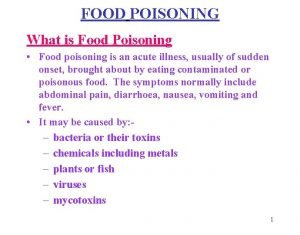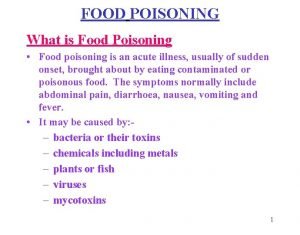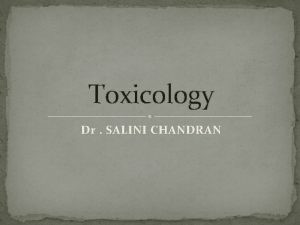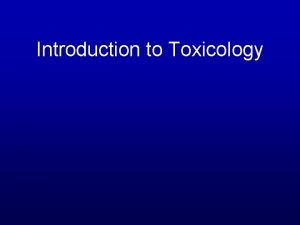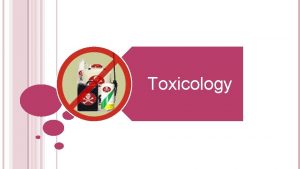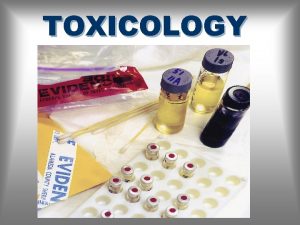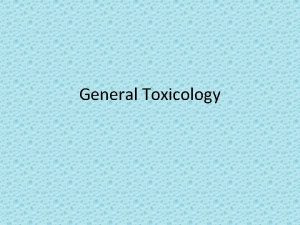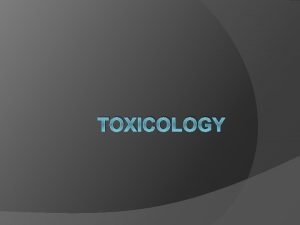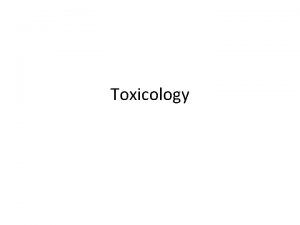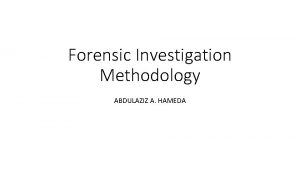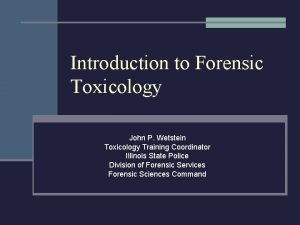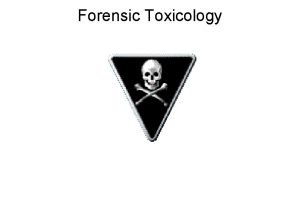INVESTIGATION OF CHILD POISONING What Can Forensic Toxicology



























































- Slides: 59

INVESTIGATION OF CHILD POISONING What Can Forensic Toxicology Offer? Michael Scott-Ham Senior Forensic Scientist Forensic Science Service, London Laboratory © Forensic Science Service Ltd. 2009. All rights reserved. The Forensic Science Service ® is a trading name of Forensic Science Service Ltd. is a UK Government owned company www. forensic. gov. uk

OUTLINE OF TALK Samples required Drugs analysed Detection times Analysis Interpretation Case examples © Forensic Science Service Ltd. 2009. All rights reserved. 2

SPECIMENS REQUIRED FROM LIVING SUBJECTS Urine (10 to 20 millilitres normally required) Blood (5 to 10 millilitres normally required) Hair (If long-term abuse is suspected) Samples must be taken as soon as practically possible. (A doctor is not necessarily required for urine samples. ) © Forensic Science Service Ltd. 2009. All rights reserved. 3

REQUIREMENTS FOR TOX SAMPLES Blood and urine need to be preserved and well sealed. Glass universal bottles/Medex® Vials/RTA Vials/Vacutainers preferable. Preservatives - fluoride, oxalate Samples should be refrigerated or frozen (frozen if volatiles are suspected). Hair Sampling – follow Hair Testing Protocol. Items suitably sealed and labeled for continuity. Date and time the sample was taken – important for result interpretation. Continuity statement likely to be required later by Police Each sample given a unique exhibit number. Use of Forensic Evidence Bags (e. g. Scene. Safe®) © Forensic Science Service Ltd. 2009. All rights reserved. 4

INFORMATION REQUIRED BY TOX Paperwork documenting case circumstances and continuity of items. Information regarding type and duration of patient symptoms. Immediate family prescription/drug use information. Suspected drugs/Alcohol? Timescale of incident – one off event/suspected long-term abuse © Forensic Science Service Ltd. 2009. All rights reserved. 5

LABORATORY PROCEDURE Alcohol Common Drugs of Abuse Amphetamine, methylenedioxymethylamphetamine (MDMA) and other associated ‘Ecstasy’ type drugs. Compounds expected following the use of cocaine. Methadone, ketamine, diazepam and temazepam. Opiate drugs (e. g. heroin, morphine, codeine and dihydrocodeine). Compounds expected following the use of cannabis or cannabis resin. Medicinal Drugs – tests carried out for basic, acidic and neutral drugs. includes various antihistamine, antipsychotic and antidepressant drugs, SSRI’s, common analgesics. As much information as possible required to assist with targeted testing. © Forensic Science Service Ltd. 2009. All rights reserved. 6

LABORATORY PROCEDURE CONT. Sedative Drugs Gamma-hydroxybutyrate (GHB) and gammabutyrolactone (GBL). Benzodiazepine drugs including flunitrazepam, diazepam, temazepam, lormetazepam, flurazepam, midazolam, alprazolam and clonazepam. Zopiclone, zolpidem and zaleplon. Barbiturates. Chlorinated compounds - chloral hydrate (‘Welldorm®’). © Forensic Science Service Ltd. 2009. All rights reserved. 7

DETECTION TIMES FOR DRUGS ARE LONGER IN URINE THAN IN BLOOD. e. g. for drugs of abuse Blood Generally 12 to 24 hours. Urine Generally 24 to 72 hours. Detection times for prescription medication vary. © Forensic Science Service Ltd. 2009. All rights reserved. 8

DETECTION LIMITS Alcohol – eliminated from an adult body at a constant rate of between 10 and 25 mg% per hour. N. B Elimination rate in children may be faster. Common drugs of abuse Blood Amphetamine ‘Ecstasy’ Cocaine Heroin/morphine Ketamine Cannabis/cannabis resin © Forensic Science Service Ltd. 2009. All rights reserved. Urine 12 hours 1 -2 days 18 hours 2 -3 days 12 hours 1 -2 days 6 - 12 hours 12 - 24 hours depends on pattern of use 9

DETECTION LIMITS CONT. Prescribed/abused drugs Blood Urine Diazepam, temazepam Methadone 2 days 1 day 4 days 2 -3 days Potential sedatives Blood Urine Flunitrazepam GHB Barbiturates 12 -24 hrs 6 hours 1+ day 3 days 12 hours 2+ days Detection time for hair samples……? © Forensic Science Service Ltd. 2009. All rights reserved. 10

ALCOHOL Alcohol tested using headspace gas chromatography. Concentration of alcohol measured in milligrams per 100 millilitres (mg%) Measured level represents situation at the time the sample was taken. Back calculation carried out to time of incident (if required) Allows for alcohol elimination between the incident and sampling time. General interpretation of effects given. Forward calculation to estimate volume of alcohol consumed/administered also possible. Child’s height and weight and drinking pattern (type of alcohol) required to carry out this calculation. © Forensic Science Service Ltd. 2009. All rights reserved. 11

DRUGS OF ABUSE Initial screening tests – Enzyme Immunoassay Analysis for common drugs of abuse. DART MS– useful for initial screening of non-biological liquids. Quick initial screens – preliminary results can be available in 24 to 48 hours. Confirmatory tests including sedative and medicinal drug screening carried out using the following techniques GC-MS HPLC LC-MS Quantification of drug concentration only carried out on blood samples Useful to obtain blood samples in addition to urine if possible. © Forensic Science Service Ltd. 2009. All rights reserved. 12

HAIR/POISONS? ? Poison Screening Can test for other compounds if circumstances suggest e. g. pesticides, metals, household chemicals? Hair testing Can be carried out segmentally to identify pattern of ingestion over weeks/months Can test for variety of drugs but generally requires bespoke methods –can be expensive Reports via a full CJ Act Witness Statement including detailed interpretation of the results obtained. © Forensic Science Service Ltd. 2009. All rights reserved. 13

QUESTIONS CONSIDERED BY THE TOXICOLOGIST Has the child been administered a drug and/or alcohol? Has the drug/alcohol been administered with the intent to cause effect? Could it have been accidental (e. g. herbal cannabis left within reach of a child? ) Inadvertent transfer through breast milk Passive inhalation Neonatal abstinence syndrome What effects would the drug/alcohol have on the child? Symptoms – dosage dependent Cause of death? Has the child been administered a drug/alcohol over an extended time period? Hair analysis © Forensic Science Service Ltd. 2009. All rights reserved. 14

CASE EXAMPLES Methadone poisoning Opiate poisoning Shannon Mathews © Forensic Science Service Ltd. 2009. All rights reserved. 15

CIRCUMSTANCES Ambulance called 5. 53 am Resuscitation attempted Child (2 y. o. ) pronounced dead 6. 47 am Ambulance had attended 7 pm previous evening Child feverish but otherwise OK; advised to give ‘Calpol® ’ every 4 hours Found at scene: Bottle of ‘Calpol® ’ ‘Chesty Cough Linctus’ Empty methadone bottle (prescribed to lodger) Other drug paraphernalia Mother still breast-feeding child © Forensic Science Service Ltd. 2009. All rights reserved. 16

POST-MORTEM EXAMINATION Carried out 3 days after death Samples taken Femoral blood (small) Heart blood Vitreous humour Stomach content © Forensic Science Service Ltd. 2009. All rights reserved. 17

ANALYSIS Heart blood screened for alcohol, common drugs of abuse and paracetamol: No alcohol detected High positive methadone EIA Paracetamol <5µg/ml Negative other drugs Femoral blood submitted for methadone quantification Insufficient blood for full quantification Methadone was confirmed as being present Contents of bottles confirmed as being as labelled (no methadone present) © Forensic Science Service Ltd. 2009. All rights reserved. 18

FURTHER ANALYSIS What now? Possibilities: Quantify heart blood, vitreous humour Other samples ? © Forensic Science Service Ltd. 2009. All rights reserved. 19

FURTHER ENQUIRIES No other samples had been taken at p-m Requested samples of muscle tissue and liver body thawed out and 4 muscle samples taken from legs as well as a sample of liver © Forensic Science Service Ltd. 2009. All rights reserved. 20

FURTHER ANALYSIS Methadone levels: Vitreous humour 0. 15µg/ml Heart blood 0. 29µg/ml Right thigh muscle 0. 72µg/g Right calf muscle 0. 71µg/g Left thigh muscle 0. 67µg/g Left calf muscle 0. 63µg/g Liver 2. 5µg/g © Forensic Science Service Ltd. 2009. All rights reserved. 21

FURTHER ANALYSIS Right thigh muscle – pholcodine detected (therapeutic level) Stomach content – <0. 02 mg methadone in total © Forensic Science Service Ltd. 2009. All rights reserved. 22

INTERPRETATION No femoral blood methadone level – possible problems with post-mortem interpretation Conversion of heart blood to femoral blood – wide range of ratios in the few published papers Little published data on muscle or liver levels No published data on vitreous humour levels -one FSS London case for comparison © Forensic Science Service Ltd. 2009. All rights reserved. 23

INTERPRETATIO N Femoral blood level (as calculated by conversion from heart blood ratio range) within the published fatal range Heart blood level typically 2 -3 times higher than lowest published fatal levels Liver level within the published fatal range Muscle levels all above the published fatal levels Vitreous humour level consistent with previous fatal case Stomach content –no suggestion of recent methadone ingestion © Forensic Science Service Ltd. 2009. All rights reserved. 24

INTERPRETATIO N Source of methadone? Defence suggested ingestion of breast milk –feasible? Methadone level in breast milk typically 0. 1 -0. 2µg/ml; highest reported 0. 57µg/ml Ingestion of one litre would deliver 0. 1 - 0. 2 mg of drug (0. 57 mg highest) Drug metabolism also occurring in interim (would not ingest one litre in one sitting!) Cannot possibly account for measured levels; likely to need minimum of 10 mg of methadone to produce measured levels © Forensic Science Service Ltd. 2009. All rights reserved. 25

OTHER EVIDENCE Hair from child Showed regular ingestion of: Methadone Cocaine Heroin Mother also a regular drug user (from hair analysis) Heroin Cocaine Methadone (although not prescribed) © Forensic Science Service Ltd. 2009. All rights reserved. 26

TRIAL (MAY 2006) Court No. 2 Old Bailey MSH gave evidence over whole of morning session (experience questioned!) ARWF gave evidence over whole of afternoon session Jury could not agree on a verdict and therefore discharged Re-trial – June 2006 Jury again failed to reach a verdict Judge recorded formal ‘not guilty’ verdict Defendant had earlier pleaded guilty to a charge of neglect © Forensic Science Service Ltd. 2009. All rights reserved. 27

CIRCUMSTANCES OF CASE 1 month old baby –died end February. Victim placed into a rucksack by parents who travelled several 100 miles to visit baby’s grandparents. Grandparents alerted the police after being shown the body. Post-mortem carried out 3 days later - no obvious cause of death. Samples submitted by police 2 months after death “for completeness” Initial samples taken included – © Forensic Science Service Ltd. 2009. All rights reserved. Blood Urine Stomach Contents 28

Parents’ house searched and the following items recovered – Karvol® Decongestant capsules x 17 + box (3 used) 20 mg Seroxat® Tablet blister pack (2 tablets remaining) Bottle of Calpol® (approx 2. 5 mls remaining). Empty Distalgesic® blister pack (Co-Proxamol) Empty bottle marked Clonazepam 24 x 0. 5 mg tablets. Empty container marked Nytol® Herbal tablets x 28 Empty bottle marked paracetamol 500 mg x 20 Various feeding bottles, milk powder, gripe water and several items of clothing also seized. © Forensic Science Service Ltd. 2009. All rights reserved. 29

ANALYTICAL FINDINGS Blood - Preserved Alcohol 15 milligrams per 100 millilitres of blood Strong positive EIA screening test for opiate drugs and specific morphine!! Urine - Unpreserved Alcohol 42 milligrams per 100 millilitres of urine Low level of micro organisms. Strong positive EIA screening test results for opiate drugs and specific morphine. © Forensic Science Service Ltd. 2009. All rights reserved. 30

ANALYTICAL FINDINGS Blood - Preserved Free Morphine 2. 1 micrograms per millilitre Total Morphine 3. 7 micrograms per millilitre (measured as morphine) Paracetamol ~ 140 micrograms per millilitre Monoacetylmorphine and codeine also detected Insufficient blood for further analysis © Forensic Science Service Ltd. 2009. All rights reserved. 31

ANALYTICAL FINDINGS Stomach Contents Morphine ~ 20 micrograms per millilitre. Total weight of stomach contents approximately 2 grams Total morphine in stomach = approximately 40 micrograms. © Forensic Science Service Ltd. 2009. All rights reserved. 32

ANALYTICAL FINDINGS Muscle sample taken at a later stage (5 th June) at my request. Muscle (Taken From Thigh) Free morphine ~2. 5 micrograms per gram of tissue. Total morphine ~3. 1 micrograms per gram of tissue. Paracetamol ~131 micrograms per gram. Propoxyphene ~3. 1 micrograms per gram. © Forensic Science Service Ltd. 2009. All rights reserved. 33

ALCOHOL Results indicate possibility that the victim had been administered alcohol prior to his death. Unable to estimate blood alcohol level at the time of death. Children can eliminate alcohol at a faster rate than adults (e. g. Gibson et al. 1985, Leung 1986, Vogel et al. 1995). Possibility of micro-organism activity prior to post-mortem (at least a 3 day period between death and post-mortem). Samples submitted 2 months later. Urine sample not preserved – micro organisms present. Unknown how samples were stored. © Forensic Science Service Ltd. 2009. All rights reserved. 34

MORPHINE/HEROIN Detection of monoacetylmorphine proves heroin ingestion. Concentration of morphine very high and within the toxic range. Ratio of ‘free’ to ‘total’ morphine consistent with ingestion of heroin within a few hours of death – although post-mortem changes must be considered inc. Possibility of morphine glucuronide breakdown to ‘free’ morphine. Post-mortem redistribution - blood sample taken from the heart. Diffusion back into the stomach. © Forensic Science Service Ltd. 2009. All rights reserved. 35

MORPHINE/HEROIN Thigh muscle sample taken at a later date to assist with interpretation. Muscle results obtained in agreement with the blood. Low level of morphine also detected in the stomach contents. Too low to substantiate method of administration – possible diffusion? © Forensic Science Service Ltd. 2009. All rights reserved. 36

PARACETAMOL AND DEXTROPROPOXYPHENE Paracetamol arisen from Calpol® and/or Distalgesic® tablet administration? Recommended dose of Calpol® to babies under 3 months is 2. 5 ml of a 120 mg/5 ml solution (60 mg paracetamol). Equivalent to approximately 15 mg paracetamol per kg body weight (15 mg/kg). Suggested maximum therapeutic paracetamol concentration - approximately 25 micrograms per millilitre following dosage at approximately 30 mg/kg (double recommended dose). Measured concentrations ~140 micrograms per millilitre in blood. ~131 micrograms per gram in muscle. The paracetamol level detected is unlikely to have been life-threatening on it’s own, however is higher than recommended. © Forensic Science Service Ltd. 2009. All rights reserved. 37

Propoxyphene was detected in the muscle sample. Propoxyphene concentrations in muscle significantly (2 -4 times) greater than in blood (e. g. Langford et al. 1998, Barnhart et al. 2001, Christensen at al. 1985). Therefore measured level of 3. 1 micrograms per gram of muscle ≡ 0. 8 to 1. 5 micrograms per millilitre of blood. Blood concentrations exceeding 1 microgram per millilitre represent serious toxicity. Combined with paracetamol results suggest possible administration of 1 to 2 Distalgesic® tablets. Paracetamol and propoxyphene also detected in stomach contents (v. low) © Forensic Science Service Ltd. 2009. All rights reserved. 38

OTHER RESULTS Glass feeding bottle contained approximately 2. 5 ml pale pink liquid. Paracetamol (~50 mg), propoxyphene (~3. 4 mg) and a trace level of morphine detected in the liquid. Paracetamol and propoxyphene also detected on the outside of the teat attached. Uncooked starch grains also seen under polarised microscope. Alcohol detected in some of the liquids analysed – produced whilst in storage? Evidence that other items of clothing seized may have been in contact with illicit heroin, cocaine, propoxyphene and paracetamol. © Forensic Science Service Ltd. 2009. All rights reserved. 39

CONCLUSIONS Deceased had ingested a potentially life-threatening amount of heroin. Unable to say how the drug was given or the amount ingested. Had also ingested a potentially toxic dose of dextropropoxyphene (and paracetamol). Significant interactions can occur between heroin and dextropropoxyphene to increase overall toxic effects inc. respiratory depression. Other results indicate that the deceased may also have been administered alcohol. Deceased had not been administered paroxetine, clonazepam or any of the other common drugs of abuse tested for prior to his death. © Forensic Science Service Ltd. 2009. All rights reserved. 40

THE TRIAL Prior to the trial there had been two defence examinations (each parent represented separately) Evidence-in-Chief Cross –examination © Forensic Science Service Ltd. 2009. All rights reserved. 41

OPERATION PARIS The Shannon Matthews Case Toxicologist: Dr Craig Chatterton © Forensic Science Service Ltd. 2009. All rights reserved. The Forensic Science Service ® is a trading name of Forensic Science Service Ltd. is a UK Government owned company www. forensic. gov. uk

OPERATION PARIS : Case Circumstances v West Yorkshire Police received a call from Karen MATTHEWS shortly before 7 pm on the 19 th February 2008 stating that her 9 year old daughter, Shannon, had not returned home from school. WYP initiate an intense search and open a major investigation v Significant media interest throughout the search including TV documentaries involving Shannon’s family v The media link this case to the (unsolved) abduction/disappearance of Madelaine Mc. Cann in Portugal the previous summer v On the 14 th March 2008, twenty-four days after going missing, Shannon is located at the home address of Michael DONOVAN v Urine sample collected forensic investigation – suspicion that Shannon may have been drugged in order to facilitate the abduction and also whilst in captivity © Forensic Science Service Ltd. 2009. All rights reserved. 43

OPERATION PARIS : Initial information / intelligence v ½ a packet of Traveleeze® (meclozine) medication found at DONOVAN’s address together with a till receipt dated 13. 08. During interview, Shannon claims to have been given a white tablet v DONOVAN’s medical records / history investigated. Drugs which form part of his recent prescription include: v Amitriptyline anti-depressant v Clonazepam anticonvulsant v Dihydrocodeine opioid analgesic v Temazepam hypnotic v Tramadol non-opioid analgesic © Forensic Science Service Ltd. 2009. All rights reserved. 44

OPERATION PARIS : Results and interpretation v Drugs detected in the urine sample: v Temazepam and its metabolite Oxazepam v Meclozine and associated metabolites v Unable, from analysis of urine sample, to determine specifically when these drugs were ingested; both drugs can cause drowsiness v A single dose of temazepam is typically detectable in urine for 2 to 3 days v Drugs have been ingested shortly before sample collection on the 14 th March 2008, i. e. , whilst Shannon in captivity rather than before she went missing © Forensic Science Service Ltd. 2009. All rights reserved. 45

OPERATION PARIS : Further investigation - hair v Initial analysis on item CAF 120 – obtained 16. 04. 08 Drug detected 0 to 3 cm 3 to 6 cm 6 to 9 cm 9 to 12 cm Amitriptyline 54 141 317 1099 Nortriptyline 35 110 189 687 Temazepam 2 6 6 8 Tramadol 110 230 450 720 Dihydrocodeine 23 21 49 67 © Forensic Science Service Ltd. 2009. All rights reserved. 46

OPERATION PARIS : Further investigation - hair v Subsequent analysis on item MEAC 1 – obtained 19. 03. 08 Drug detected 0 to 3 cm 3 to 6 cm 6 to 9 cm 9 to 12 cm Amitriptyline 124 528 1097 1484 Nortriptyline 72 284 513 609 Temazepam 4 9 23 37 Tramadol 500 1300 2500 5000 Dihydrocodeine 100 300 900 1200 © Forensic Science Service Ltd. 2009. All rights reserved. 47

OPERATION PARIS : Further investigation - hair v Subsequent analysis on item AJG 10 – obtained 23. 05. 08 Drug detected 0 to 3 cm 3 to 6 cm 6 to 9 cm 9 to 12 cm 12 to 15 cm 15 to 18 cm Amitriptyline 5 19 61 121 156 182 Nortriptyline 2 13 46 83 111 114 Temazepam 2 4 7 9 13 12 Tramadol 30 90 220 380 540 860 Dihydrocodeine 10 20 40 90 120 140 © Forensic Science Service Ltd. 2009. All rights reserved. 48

OPERATION PARIS : Initial interpretation v Findings demonstrate the ingestion of each drug by Shannon Matthews v Pattern / distribution indicates ingestion on more than 1 occasion v Presence of drug in each segment indicates extended period of time v Ingestion occurred before February 2008, i. e. , before disappearance v Could indicate ingestion over period of greater than 12 months v Growth rate varies between 0. 7 and 2. 2 cm / month v Average growth rate is 1 cm per month © Forensic Science Service Ltd. 2009. All rights reserved. 49

OPERATION PARIS : Interpretation issues v Can we be certain of orientation ? v When did the ingestion of drugs begin ? v Why is the concentration of drug highest at the distal end ? v Can a dosage be estimated from the concentration detected in hair ? v Is there anything special about the mixture of drugs ? v Can a more definitive pattern of ingestion be established / investigated ? v Can the rate of hair growth be established ? © Forensic Science Service Ltd. 2009. All rights reserved. 50

OPERATION PARIS : Interpretation issues v Can we be certain of orientation ? v Yes – this was verified by microscopic analysis v When did the ingestion of drugs begin ? v Require growth rate and more analysis to determine v Why is the concentration of drug highest at the distal end ? v Not yet known – several possibilities v Can a dosage be estimated from the concentration detected in hair ? v No, not really © Forensic Science Service Ltd. 2009. All rights reserved. 51

OPERATION PARIS : Interpretation issues v Is there anything special about the mixture of drugs ? v Similar effects, i. e. , drowsiness v All part of DONOVAN’s prescription v Can a more definitive pattern of ingestion be established / investigated ? v Yes but this requires more analysis v Can the rate of hair growth be established ? v Yes, West Yorkshire Police to take this forward © Forensic Science Service Ltd. 2009. All rights reserved. 52

OPERATION PARIS : Interpretation issues © Forensic Science Service Ltd. 2009. All rights reserved. 53

OPERATION PARIS : Interpretation issues © Forensic Science Service Ltd. 2009. All rights reserved. 54

OPERATION PARIS : Interpretation issues © Forensic Science Service Ltd. 2009. All rights reserved. 55

OPERATION PARIS : Final interpretation & conclusions v Shannon Matthews ingested drugs during her time period in captivity v In the day or so prior to her discovery on the 14 th March 2008, Shannon Matthews had ingested the prescription-only hypnotic drug temazepam and the antihistamine / antiemetic drug meclozine v Hair analysis demonstrates that Shannon Matthews had ingested amitriptyline, temazepam, tramadol, dihydrocodeine and meclozine in the months leading up to her disappearance in February 2008 v The findings demonstrate ingestion on more than one occasion; the distribution of the drugs in Shannon’s hair indicates that all of these drugs were ingested during the same time periods v Based on the established growth rate, the peak in drug concentration in the 10 to 11 cm segment coincides with a time period between January and April 2007 v Based on the established growth rate, the peak in drug concentration in the 16 to 17 cm segment coincides with a time period between May and August 2006 © Forensic Science Service Ltd. 2009. All rights reserved. 56

OPERATION PARIS : Leeds Crown Court Nov 11 – Dec 2 v On Tuesday 2 nd December, after 6 hours of deliberations, a unanimous verdict was returned v Karen MATTHEWS and Michael DONOVAN were found guilty of all charges v Kidnap, False Imprisonment and Perverting the Course of Justice v Judge indicated that both persons should expect a lengthy custodial sentence © Forensic Science Service Ltd. 2009. All rights reserved. 57

Acknowledgements With thanks to: v Elizabeth Hird for preparing the presentation v Craig Chatterton (FSS Chorley) who reported the Shannon Matthews case v. Contact details: E-mail: Michael. Scott-Ham@fss. pnn. police. uk Tel. : 020 -7160 -4254 © Forensic Science Service Ltd. 2009. All rights reserved. 58

© Forensic Science Service Ltd. 2009. All rights reserved. 59
 Important dates in forensic science
Important dates in forensic science Breath tests reflect alcohol concentration in which artery?
Breath tests reflect alcohol concentration in which artery? A breath test reflects the alcohol concentration where
A breath test reflects the alcohol concentration where Definition of forensic toxicology
Definition of forensic toxicology Forensic toxicology lab activity
Forensic toxicology lab activity Forensic toxicology vocabulary
Forensic toxicology vocabulary Forensic science foodborne outbreak investigation answers
Forensic science foodborne outbreak investigation answers Common factors that can lead to food poisoning
Common factors that can lead to food poisoning Thomas mocker and thomas stewart
Thomas mocker and thomas stewart Forensic psychiatry vs forensic psychology
Forensic psychiatry vs forensic psychology Observation in forensic science
Observation in forensic science 패자트리
패자트리 Toxicology terms
Toxicology terms Tera toxicology
Tera toxicology Environmental toxicology definition
Environmental toxicology definition Chapter 8 toxicology poisons and alcohol
Chapter 8 toxicology poisons and alcohol Chapter 8 toxicology poisons and alcohol
Chapter 8 toxicology poisons and alcohol Toxicology management
Toxicology management Wsp toxicology lab
Wsp toxicology lab Toxicology definition
Toxicology definition Toxicology and applied pharmacology
Toxicology and applied pharmacology Nc ocme
Nc ocme Toxicology
Toxicology Examples of toxicology
Examples of toxicology Therapeutic index
Therapeutic index Toxicology
Toxicology Toxicology defination
Toxicology defination Toxicology
Toxicology Annual review of pharmacology and toxicology
Annual review of pharmacology and toxicology Importance of toxicology
Importance of toxicology Toxicology effects
Toxicology effects Toxicology effects
Toxicology effects Ld50 examples
Ld50 examples Hormesis definition
Hormesis definition Food safety and toxicology
Food safety and toxicology Drug identification and toxicology
Drug identification and toxicology Dumbels emt
Dumbels emt A small dose of toxicology
A small dose of toxicology Subcostal retractions
Subcostal retractions Dioxin poisoning
Dioxin poisoning Dioxin poison
Dioxin poison Top trumps food
Top trumps food B. cereus food poisoning
B. cereus food poisoning Dioxin poisoning
Dioxin poisoning Seo poisoning wikipedia
Seo poisoning wikipedia Poisoning the well fallacy
Poisoning the well fallacy Organophosphate toxicity
Organophosphate toxicity Methanol poisoning
Methanol poisoning Mercury poisoning symptoms
Mercury poisoning symptoms Whats lead poisoning
Whats lead poisoning Kecelakaan lalu lintas icd 10
Kecelakaan lalu lintas icd 10 What is oxygen poisoning
What is oxygen poisoning Food poisoning onset
Food poisoning onset Endaru tree
Endaru tree Prinso poisoning
Prinso poisoning Chapter 17:6 providing first aid for burns
Chapter 17:6 providing first aid for burns Bgp poisoning
Bgp poisoning Arp cache poisoning attack fix
Arp cache poisoning attack fix Temazolam
Temazolam Diya kaduru
Diya kaduru

